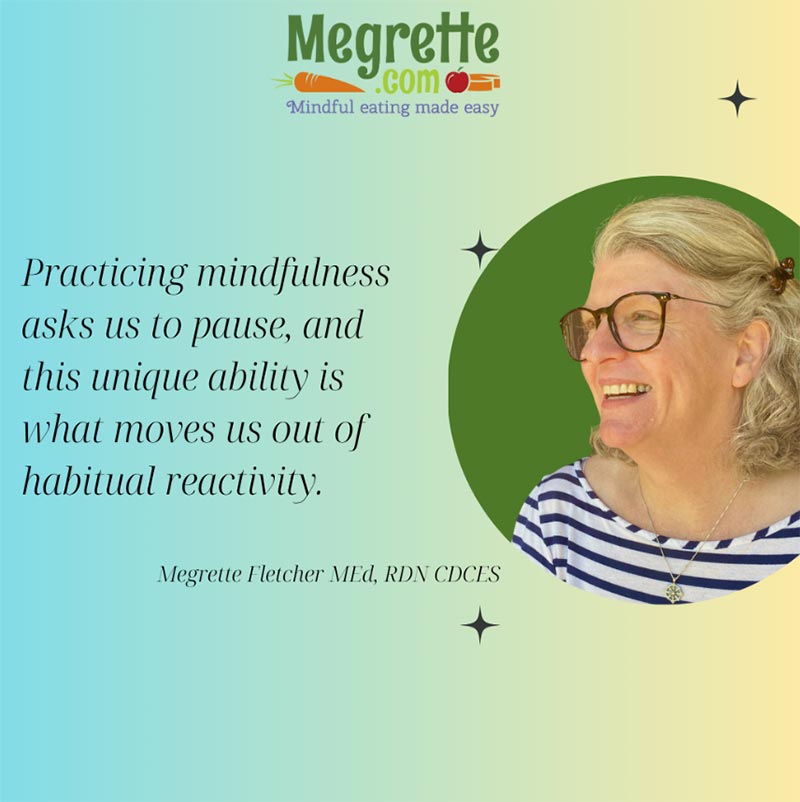To all my fellow Leos, Happy Birthday! This month I want to explore how a mindfulness practice can help reduce stigma in diabetes care. For those new to my newsletter, thank you for being curious and trusting me to guide your learning. Each month I try to weave together how mindfulness and inclusive care can help clients with diabetes. I also own Inclusive Diabetes Care, a professional educational company that provides monthly CPE for healthcare professionals. The IDC also has a newsletter and a podcast to help accelerate untangling the knot of stigma.

How can mindfulness help reduce stigma?
There are many ways mindfulness can help reduce stigma. I don’t want to list them all, but mindfulness is part of self-compassion. Practicing mindfulness asks us to pause, and this unique ability is what moves us out of habitual reactivity. For example, you notice you are upset, irritable, and generally grumpy. These are unpleasant feelings, so you wonder, “Why am I so irritable?” A reaction might sound like, “Oh, I bet it is because of…” This reaction is familiar, so it is easy to think mindfulness is about playing detective so you can learn why you are grumpy. However, mindfulness is the pause, the curiosity, and the awareness that being grumpy isn’t your “normal” state of being. Mindfulness is part of self-compassion, and this compassion instinctively knows your “normal” state of being isn’t as simplistic as a single feeling, it is also made up of joy, love, and happiness.
The analogy used to teach meditation is that your mind is like the blue sky. Unfortunately, we have the habit of seeing the clouds, focusing on the clouds. Over time it is easy to assume the cloud is who we are. If the cloud is a dark storm cloud, aka a grumpy mood, then because we identify with the cloud, we label ourselves “a grumpy person.”
Mindfulness is the ability to see that you are not a grumpy mood. Your mood (happy, sad, or somewhere in between) is simply present. Mindfulness helps us see the sky is not the clouds but that the clouds are simply present.
The ability to pause and differentiate between seeing stigma is present and being hurt by it is how mindfulness helps. Mindfulness is a practice. Mindful eating is being mindful when eating. I wrote this definition of mindful eating.
Mindful eating is the INTENTION to be in the present moment and the COMMITTED PRACTICE of compassionately returning to the present moment without judgment when eating.
Why define mindful eating?
Definitions create a line in the sand, allowing you to organize your thoughts. So many people think mindful eating is simply chewing your food more or only eating foods that make you happy. These beliefs limit your understanding of mindful eating. Take some time this August and write your own definition of mindful eating.

You may wonder why I placed INTENTION and COMMITTED PRACTICE in capitals. Our intention matters. It matters in our legal system, and it matters in life. When we are ignorant of our intention, we can unintentionally create harm. The expression, “The road to hell is paved with good intentions, ” highlights this cautionary warning. Ethically, we must become conscious of our intentions and see how they may impact our lives. Mindful eating is an antidote to dieting IF we can become aware of our larger intention. Is it to restrict choices and calories to promote weight change? If so, the intention isn’t to be in the present moment. If the intention to be in the present moment (noticing our direct experience when eating), then when we get distracted by a thought (like what if by eating this way, I lose weight) then we can compassionately return to the present moment (checking in with the body) without judgment when eating (because distraction is a normal experience).
Committed practice means mindfulness and mindful eating are not a one-and-done approach to life. It takes practice, and with practice, layers of awareness emerge. I have been practicing for over 25 years and I never feel like “I got it – no need to practice being in the present moment.”
Getting good isn’t the point of mindfulness. In fact, the idea of ‘getting good’ is just another layer of judgment, which is distracting. The point is to practice pausing so awareness and, hopefully, wisdom and insight can arise. The awareness that there are many things for which I am “hungry.” The wisdom to know what will nourish my body and being. The insight sometimes means I need to sit with cravings compassionately. Mindful eating is about being human, so when normal missteps arise, I have the awareness, insight, and wisdom to practice compassion.
How self-compassion helps us increase our tolerance.
Gaining emotional strength is not much different than getting physically stronger. We have to get our emotional reps each day. The question is, where can you go to practice?
I recommend The Center for Mindful Eating, The Othering and Belonging Institute, and for those who want to focus specifically on diabetes, Inclusive Diabetes Care.
What do these organizations offer?
- TCME.org offers mindful eating practice sessions, professional training, and the Mindful Eating Certificate.
- The Othering and Belonging Institute offers practice sessions on belonging. These are very effective if you are looking to unpack racial stigma.
- Inclusive Diabetes Care offers monthly peer coaching for members. The IDC membership is $249.00 annually, providing 22 events each year including 10 peer coaching sessions and 12 CPE events.

